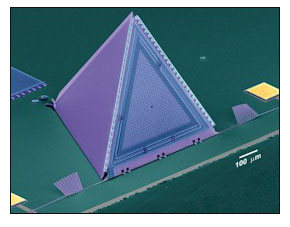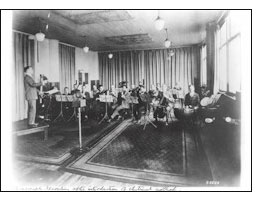MURRAY HILL, N.J., Jan. 10, 2006 -- Bell Labs, the research and development arm of Lucent Technologies, today announced it was awarded a technical Grammy by The National Academy of Recording Arts and Sciences for its contributions to the recording field. This is the first technical Grammy ever awarded to a communications research laboratory, the company said.

An electron-scanned image of a nano-based mini-microphone, manufactured by Bell Labs at its nanotechnology/MEMS fabrication facility. (Photo courtesy Lucent Technologies Bell Labs)
The technical Grammy will be presented Feb. 7 at the Wilshire Ebell Theatre in Los Angeles, and the 48th Annual Grammy Awards will be held Feb. 8 at the Los Angeles Staples Center.
From the invention of the telephone, the first device to electronically transmit and receive sound, to its more recent R&D projects for digital sound capture and delivery technologies, Bell Labs has been a pioneer in the foundational and applied technologies of modern sound recording, electronic transmission and digital communications. Seminal Bell Labs sound and audio inventions include high-fidelity recording (1925), single groove stereo recording (1933), stereophonic recording on film (1941), the laser (1958) -- today used in all CD and DVD players, the electret microphone (1966) and advances in audio compression to facilitate digital radio technology (1992-1999), which allows AM, FM and satellite stations to broadcast near-CD quality music.

In this 1925 Bell Labs photo, musicians record a performance using an early system to electronically capture, amplify and record sound onto a wax disk, making the recording session more natural and also dramatically improved the quality of the recorded sound. Prior to this innovation, the musicians needed to all huddle around a large cone that would directly transfer sound vibrations to a wax disc with no electronic amplification or filtering. (Photo courtesy Lucent Technologies Bell Labs)
Current research and development at Bell Labs include audio as part of a blended multimedia experience; work on new digital compression technologies for delivering music and other medias over a wide variety of networks and devices; nano-based "micro-microphones" for dynamically directional, high-quality sound recording; and flexible and tunable hypersensitive recording arrays for improved sound capture. Some of Bell Labs’ longer-term research projects in this area include the investigation of new types of lasers, materials and processing formats that it says have the potential to yield the next generation of high density media storage and advanced digital playback technologies.
"Bell Labs continues to be laser-focused on communication innovations, the fruits of which continue to enrich our everyday lives by providing continual improvements for how we create, capture and enjoy digital entertainment such as music," said Sid Ahuja, vice president of Software Media Research, which oversees current multimedia, digital entertainment, acoustics and speech research efforts.
For more information, visit: www.bell-labs.com/sound
/Buyers_Guide/Lucent_Technologies_Bell_Labs_Innovations/c8804